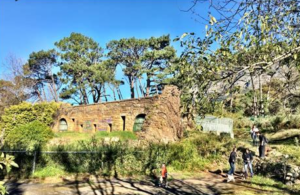Groot Schuur zoo
Groot Schuur zoo was a project conceived by Cecil John Rhodes who was Prime Minister of the Cape Colony from 1890 to 1896. He bought a 2-hectare piece of land on the slopes of Devils Peak in 1893. At the time there was an abundance of wildebeest, leopard and wildcats, deer, duiker, eland, ostriches and zebra.
He planned to build a Paestum temple of colonnades to house lions, where people could admire their natural strength. However, this was not built and a cage-like structure was built instead.
When he died in 1902 Rhodes bequeathed the property to the state. In 1930 this structure was demolished and replaced by a new lion enclosure. Wire-fenced cages and large aviaries were built to house his private menagerie. The now derelict Groote Schuur Zoo is a popular attraction in Cape Town with its abundance of shady oak and pine trees with masses of beautiful hydrangeas.
The idea was for all to have free access to the area for an affordable family outing. There were huge aviaries with birds in many shapes sizes and colours. Screaming peacocks strutted everywhere fanning their tail feathers and showing off. Penguins were fenced in a very large aviary with a long pond. It is said there was even an elephant and a camel living here.



There is a story that there was a kudu bull that repeatedly got into, and damaged the garden at Rudyard Kipling’s home (known as The Woolsack which is a National Monument at UCT,)
Entrance to the Groot Schuur zoo was free and it was a very popular attraction in Cape Town until its closure sometime between 1975 and 1985. The zoo shut down due to a combination of the financial burden that the Apartheid government faced, and an increase in animal welfare standards.
The abandoned buildings stand there still covered in vegetation. At one point during the time the zoo was in operation, two tahirs, a breed of Himalayan mountain goat, escaped up Table Mountain. These goats bred and quite a large population grew that lived on the mountain. In 2000, it was decided to cull them due to the environmental damage they caused. However, while they are rare, there is still a small population of goats on the mountain.


